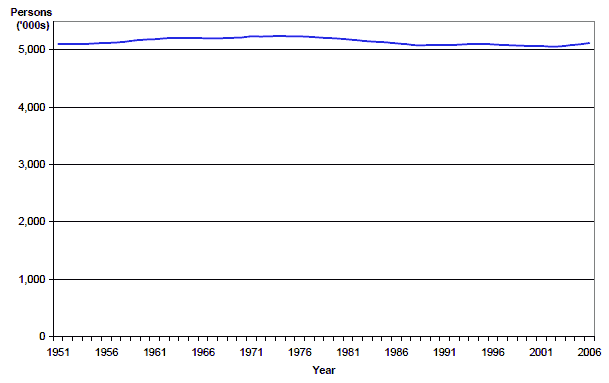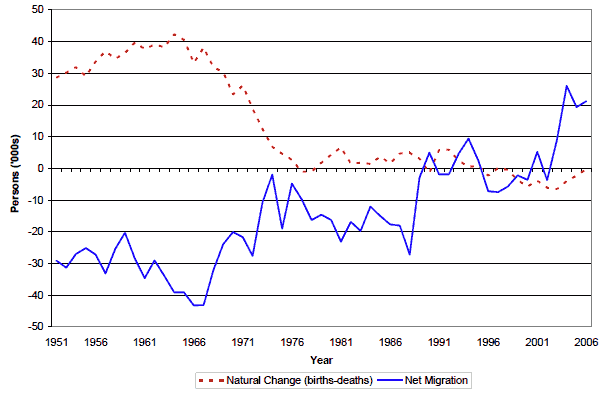
2.1 The estimated population of Scotland on 30 June 2006 was 5,116,900, a rise of 22,100 on the previous year and an increase of 52,700 since mid-2001. In the twelve months to mid-2006, there was a net migration gain of 21,200, reflecting a net gain of 8,900 people from the rest of the UK, a net gain of 12,700 from overseas (including asylum seekers), an adjustment of -1,500 for unmeasured migration (see the notes and definitions section for more details) and a net gain of 1,100 movements to and from the armed forces. Other changes (including changes in the prison population, and changes in the number of armed forces stationed in Scotland) amounted to an increase of 1,200 people. Compared with the previous year there were more births (+1.3 per cent) and fewer deaths (-2.3 per cent). The number of deaths in the twelve months up to mid-2006 exceeded the number of births by 300, compared with 2,300 in the previous year.
2.2 The population increased for the fourth year in a row because more people came to Scotland than left. Around 53,300 people came to Scotland from England, Wales and Northern Ireland and 44,400 left Scotland to go in the opposite direction. The net inflow of 8,900 was lower than the previous year’s 12,500 net inflow reflecting less people coming to Scotland, while the number of people leaving to go to the rest of the UK remained the same as the previous year.
2.3 The overseas net gain of 12,700 came from an inflow of 42,200 (including asylum seekers) and an outflow of 29,500. The net gain from overseas was higher than the previous year’s net inflow of 7,300. Estimating international migration is particularly difficult as the estimate is based primarily on the International Passenger Survey (IPS) which is a sample survey conducted at main airports and ports across the UK, and the sample size for Scotland is very small (around 140 contacts in 2006). Internationally, a migrant is defined as someone who changes their country of usual residence for 12 months or more, therefore, short-term seasonal migrant workers will not be counted in the migration estimates, and hence will not be counted in the mid-year population estimates. More details about the migration data sources and definitions used can be found in Section 6.
2.4 For comparison purposes it is better to look at a time frame of longer than one year, as population change tends to fluctuate from year to year, particularly for smaller areas. Between mid-2001 and mid-2006, Scotland’s population increased by 1.0 per cent (+52,700) from 5.06 million to 5.12 million (Table 5). However, between mid-1996 and mid-2006, Scotland’s population increased by 0.5 per cent (+24,710) from 5.09 million to 5.12 million (Table 6 and Figure 1). As shown by Figure 2, the main reason for the smaller increase over the longer period is that there was a negative net migration for the early years of the period 1996-2006. The natural change (births minus deaths) was also negative for most of this period, though the figure of -295 for the most recent year reflects the closest gap between births and deaths since 1997.


2.5 Table 8 shows movements to and from the UK and overseas between mid-2005 and mid-2006 by age group. The main source of data for the overseas migration calculations is the International Passenger Survey and as the sample size was small for Scotland (about 140) an age and sex distribution is assumed using information about GP registrations. The method used to estimate international migration is described in Section 6.
2.6 Migrants tend to be younger than the general population. For in-migrants to Scotland, 48 per cent of those from the rest of the UK and 69 per cent of those from overseas were aged 16-34 years, compared with 24 per cent of the resident population for this age group. Only 5 per cent of people coming to Scotland from the rest of the UK were aged 65 and over.